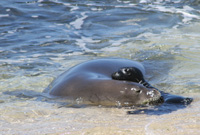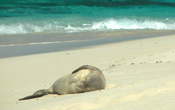Hawaiian Monk Seal (Neomonachus schauinslandi)

Hawaiian Monk Seal
(Neomonachus schauinslandi)
Photo: NOAA

Hawaiian Monk Seal Range Map
(click for larger view PDF)

Hawaiian Monk Seal
Critical Habitat
(click for larger view PDF)
» Proposed Revision to Critical Habitat
Did You Know?
- Revised genus from "Monachus" to "Neomonachus" effective 01/16/2015
- Monk seals are named for the folds of skin on their head that look like a monk's hood and because they spend most of their time alone or in small groups.
- The Hawaiian name is "llio holo I ka uaua" meaning "dog that runs in rough water. Also Known as ‘illio holo kai, ‘illio holo i ke kai, na mea hulu, and sila or kila.
MMPA Depleted - throughout its range
CITES Appendix I - throughout its range
Hawaiian monk seals are one of NOAA Fisheries' Species in the Spotlight 
- Hawaiian Monk Seal Spotlight Species 5-Year Action Plan
- Main Hawaiian Island Monk Seal Management Plan Released (1/15/16)
- Pacific Islands Fisheries Center monk seal research
- Pacific Islands Fisheries Regional Office monk seal management
- Hawaiian monk seal recovery plan
- Other NOAA Fisheries Species in the Spotlight
|
Weight:
|
375-450 pounds (170-205 kg) |
|
Length:
|
7.0-7.5 feet (2.1-2.3 m) |
|
Appearance:
|
silvery-grey backs with lighter creamy coloration on their underside; newborns are black. They may also have light patches or red and green tinged coloration from attached algae. |
|
Lifespan:
|
25-30 years |
|
Diet:
|
fish, cephalopods, and crustaceans |
|
Behavior:
|
monk seals breed and haul-out on sand, corals, and volcanic rock; they are often seen resting on beaches during the day |
The Hawaiian monk seal is one of the rarest marine mammals in the world. Part of the "true seal" family (Phocidae), they are one of only two remaining monk seal species. The other is the Mediterranean monk seal. A third monk seal species--the Caribbean monk seal--is extinct.
Isolated from their closest relative 15 million years ago, Hawaiian monk seals are considered a "living fossil" because of their distinct evolutionary lineage.
Females generally mature around age 5; it is unknown when males mature. Monk seals are promiscuous and mate underwater. Given male-dominated sex ratios at some breeding colonies, group mobbing of "estrus" females is known to occur, sometimes causing serious injury or even death to the female.
The gestation period is 10-11 months. Birthing rates vary with a range of 30-70% of adult females birthing in a given year. While most births occur in late March and early April, birthing has been recorded year round. Newborns are black, and then molt near the end of their nursing period.
Nursing occurs for about 1 month, during which time the mother fasts and remains on land. After this period, the mother abandons her pup and returns to sea. Although they are generally solitary animals, females have been observed fostering others' offspring.
Monk seals are primarily "benthic" foragers, feeding on a variety of prey including fish, cephalopods, and crustaceans. Their diet varies by location, sex, and age. Monk seals generally hunt for food outside of the immediate shoreline areas in waters 60-300 feet (18-90 m) deep. Monk seals are also known to forage deeper than 1,000 feet (330 m), where they prey on eels and other benthic organisms.
Tiger sharks and Galapagos sharks prey on monk seals.
Monk seals live in warm subtropical waters and spend two-thirds of their time at sea. They use waters surrounding atolls, islands, and areas farther offshore on reefs and submerged banks. Monk seals are also found using deepwater coral beds as foraging habitat. When on land, monk seals breed and haul-out on sand, corals, and volcanic rock. Sandy, protected beaches surrounded by shallow waters are preferred when pupping. Monk seals are often seen resting on beaches during the day.Hawaiian Monk Seal satellite tracking
(Neomonachus schauinslandi)
Credit: NOAA Pacific Islands
Fisheries Science Center

Hawaiian Monk Seal
(Neomonachus schauinslandi)
Photo: NOAA Pacific Islands
Fisheries Science Center
Hawaiian monk seal critical habitat, which was recently revised in 2015 (80 FR 50925), has been designated in waters of the main Hawaiian islands and northwestern islands. More information on Hawaiian monk seal critical habitat is available on our Pacific Islands Regional Office website.
The Hawaiian monk seal's entire range is within U.S. waters. The majority of monk seals live in six main breeding subpopulations in the Northwestern Hawaiian Islands (NWHI) at:
- Kure Atoll
- Midway Islands
- Pearl and Hermes Reef
- Lisianski Island
- Laysan Island
- French Frigate Shoals
Smaller breeding sub-populations also occur on Necker Island and Nihoa Island. Monk seals have been observed at Gardner Pinnacles and Maro Reef.
Most of the population is within the Papah?naumoku?kea Marine National Monument, which was designated in 2006.
A small but growing population of monk seals is also found on the Main Hawaiian Islands (MHI), where births have occurred on all of the major islands.

Hawaiian Monk Seal mom and pup
(Neomonachus schauinslandi)
Photo: NOAA

Hawaiian Monk Seal
(Neomonachus schauinslandi)
Photo: NOAA Pacific Islands
Fisheries Science Center

Hawaiian Monk Seal
(Neomonachus schauinslandi)
Photo: NOAA
- Food limitations in NWHI, especially for juveniles and sub-adults
- Entanglement in marine debris
- Human interactions (especially in the MHI), including:
- bycatch in fishing gear
- mother-pup disturbance on beaches
- exposure to disease
- Loss of haul-out and pupping beaches due to erosion in NWHI
- Disease outbreaks
- Male aggression towards females
- Low genetic diversity
NOAA Fisheries and partners are implementing the Recovery Plan [pdf] for the Hawaiian monk seal.
Research investigating resource availability, foraging behavior (including use of crittercam ![]() ), reproduction, and disease will help scientists and resource managers make better decisions.
), reproduction, and disease will help scientists and resource managers make better decisions.
Public education campaigns, including projects to reduce monk seal-human interactions on the MHI, are building awareness about conserving the species and habitat.
Volunteer groups are being expanded to help rescue and rehabilitate animals and prevent undue stress by keeping beachgoers away from resting animals. Direct efforts to disentangle seals and remove debris from haul-out sites have led to the removal of 492 metric tons (over 1 million pounds) of marine debris in NWHI since 1996, reducing injuries and death due to entanglement and digestion of marine debris.
The Hawaiian monk seal is listed as "endangered" in the IUCN Red List of Threatened Species ![]() .
.
We developed a video, "Good Neighbors: How to Share Hawaii's Beaches with Endangered Hawaiian Monk Seals," to enhance understanding of human-seal interactions and the direct impact that has on the population and recovery of the monk seal species:

Video: How to Share Hawaii's Beaches with Endangered Monk Seals
Credit: NOAA Pacific Islands Regional Office

Recovery Plan Signing
Photo: NOAA

Hawaiian Monk Seal
(Neomonachus schauinslandi)
Photo: NOAA Pacific Islands
Fisheries Science Center
In 1976, the Hawaiian monk seal was listed as endangered under the Endangered Species Act.
Under the MMPA, Hawaiian monk seals are classified as "strategic stocks" and are considered "depleted".
We first designated critical habitat [pdf] in May 1988 (53 FR 18988) and revised the designation in August 2015 (80 FR 50925).
Hawaiian monk seals are also listed on Appendix I of the Convention on International Trade in Endangered Species (CITES).
Kingdom: AnimaliaPhylum: Chordata
Class: Mammalia
Order: Carnivora
Family: Phocidae
Genus: Neomonachus
Species: schauinslandi (All documents are in PDF format.)
- Hawaiian Monk Seal Recovery Actions Programmatic Environmental Impact Statement (PEIS)
- FAQs about the Hawaiian Monk Seal "H?'ailona" (a.k.a. "KP2")
- NOAA Pacific Islands Fisheries Science Center (PIFSC) species research and enhancement
- NOAA Pacific Islands Regional Office Hawaiian Monk Seal recovery
- Northwestern Hawaiian Islands National Marine Sanctuary Hawaiian Monk Seal Species Card, with video
- NOAA Ocean Explorer
» Video: Swimming at Depth of Over 540 Meters
» Video: Swimming in Shallow Coral Reef Habitat - Marine Mammal Commission Species Information
- U.S. Fish & Wildlife Service Hawaiian Monk Seal Species Profile
Updated: February 10, 2016


